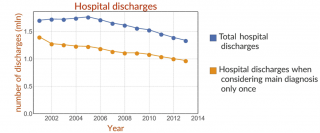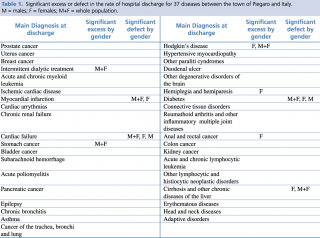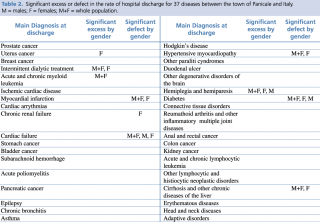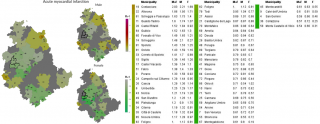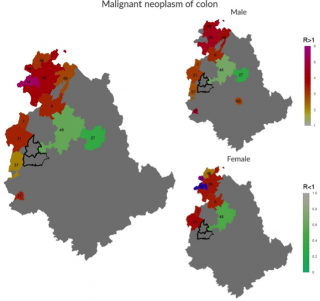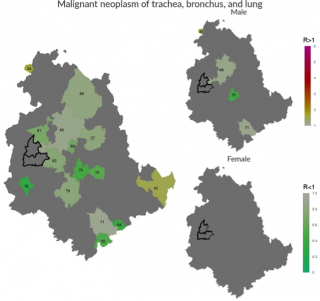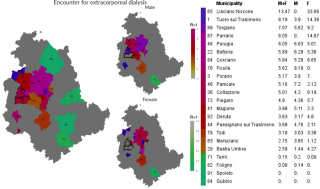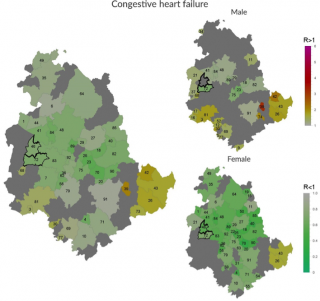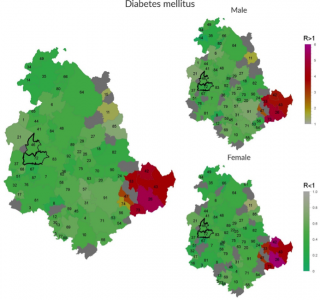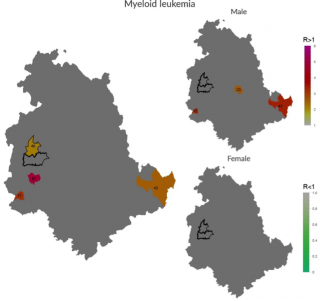Epidemiological analysis of possible environmental-related health problems in two small towns of the Italian Region Umbria
Antonio Pietroiusti,1 Francesca Lucaroni,1* Nicola Toschi,1 Andrea Duggento,1 Leonardo Palombi1
1Department of Biomedicine and Prevention, University of Rome Tor Vergata; biomedicine.prevenzione@med.uniroma2.it
*Correspondence: Dr. Francesca Lucaroni; f.lucaroni@gmail.com
Introduction
The increased awareness of possible adverse effects of environmental pollution has elicited in recent years a series of surveillance measures programs regarding the environment (in particular the quality of air and soil).1-4 In the case of potentially dangerous levels of these substances, epidemiological surveys regarding the health status of the involved populations are performed, in order to assess the presence and extent of possible adverse clinical outcomes linked to their exposure.5, 6 Sometimes, however, such surveys are performed under the pressure of the public opinion and politicians, on the basis of anedoctical reports of severe diseases such as neoplastic disorders or leukemia, which are potentially linked to exposure to pollutants. This is the case of two small cities of Umbria (Piegaro and Panigale) where the possibility of an increased incidence of leukemia linked to the presence of an ash deposit and to a possible illegal management of waste disposal has been raised.7
In order to test whether there is scientific evidence of such concerns, we performed an epidemiological survey in which the rate of hospital diagnosis for the most common diseases (including those potentially linked to air pollution) in the two towns and in the other urban centers of the Region was compared with that observed in Italy.
Materials and Methods
Analysis of the Available Data
We collected the diagnoses made at hospital discharge during 14 consecutive years (2001-2013) corresponding to the following ICD9 codes:
(045, 151, 153, 154, 155, 157, 162, 172, 174, 179, 185, 188, 189, 201, 202, 204, 205, 250, 309, 331, 332, 342, 344, 345, 401, 402, 410, 414, 427, 428, 430, 491, 493, 518, 532, 571, 585, 695, 710, 714, 784, V56)
The following data were available:
1. Permanent address (town code);
2. Sex;
3. Age;
4. ICD9 code of the main diagnosis at discharge;
5. Patient code.
In order to refer the number of hospitalizations to the resident population (including age and sex), collected data have been integrated with a demographic database. To this aim, we have chosen the population resident in Italy on 1st of January, 2012 (source: Italian Institute of Statistics). The number of residents has been considered for each Italian town, for each age group (range 0-100 years) and for both sexes.
Exclusion Criteria
In the case of multiple hospitalizations for the same disease (i.e. the same main diagnosis at discharge) only the diagnosis made at the first hospitalization has been considered. As shown in Figure 1, this criterion translates into a lower number of hospital discharges and in a somewhat different temporal trend of hospitalizations.
Number of hospital discharges when considering any diagnosis (upper line) or when considering the main diagnosis only once (lower line).
The temporal trends are shown in figure 2.
Temporal trend of diseases in Italy
Analysis of the Data
For each main diagnosis corresponding to a given ICD9 code, we evaluated if the rate of hospitalization in the two towns of Piegaro and Panigale was significantly higher in comparison to the rate of hospitalization in Italy, after normalization for age and sex. The same procedure was applied to the other towns of the Umbria Region. A p < 0.05 has been considered as significant.
Correction for multiple comparisons was made, in order to avoid the false discovery rate (FDR) phenomenon.
Comparison Between the Town of Piegaro and Italy
Table 1 shows any significant excess or defect in the diagnoses of 37 diseases in comparison to Italy.
Significant excess or defect in the rate of hospital discharge for 37 diseases between the town of Piegaro and Italy
The same data regarding Panicale are shown in Table 2.
Significant excess or defect in the rate of hospital discharge for 37 diseases between the town of Panicale and Italy
Figures 3-10 show the incidence data for all towns of the Umbria Region. Each figure includes 3 maps, one referring to the whole population (left side of the figure), and the other two to the male sex (right side, upper portion of the figure) and to the female sex (right side, lower portion of the figure). The diagnoses showing a risk higher than 1 in comparison to Italy are highlighted in color scales ranging from brown to violet for diagnoses showing a risk >1, and from light green to deep green for diagnoses showing a risk <1. The color scales are represented in bars on the right side of each figure. In the maps, towns are identified by means of a unique number; this number, along with the name of the town, the risk carried by residents (M = males, F = females, M+F = whole population) and the color scale of the risk are reported at the bottom of the figure. The borders of the two towns of interest (Panigale and Piegaro) are highlighted in bold.
Incidence of acute myocardial infarction in Umbria Region.
[pbp_image:5]
Incidence of malignant neoplasm of colon in Umbria Region.
Incidence of malignant neoplasm of trachea, bronchus, and lung in Umbria Region.
Incidence of extracorporeal dialysis in Umbria Region.
Incidence of congestive heart failure in Umbria Region
Incidence of Diabetes mellitus in Umbria Region
Incidence of Myeloid leukemia in Umbria Region
Discussion
In order to evaluate the general health status of the residents of Panigale and Piegaro, two towns of the Umbria Region for which concerns about possible environmental-related possible adverse on health have been raised, we assessed the incidence of 39 clinical diagnoses made at hospital discharge during the years 2001-2013. By comparing the incidence of these diagnoses in the two towns with that of Italy during the same time-period, no clear trend was identified. In fact, 5 diseases in excess and 4 in defect in Piegaro; and 4 diseases were in excess and 6 in defect in Panicale.
For the overwhelming majority of the diseases, there was no significant difference in excess or defect. Overall, these data suggest the absence of local factors impacting on the health status of residents.
In detail, among the diseases in excess none showed a significantly higher incidence in both sexes and in both towns. In the case of “Chronic intermittent dyalitic treatment”, an excess was detected in both towns but only considering together the male and the female population. This finding may be of some interest, since, as shown in the maps, a similar situation was present in the neighbouring towns. On the other hand, the absence of any excess in the incidence of chronic renal failure (which was indeed in defect in the female sex population of Panicale) makes troubling the interpretation of these data, since chronic renal failure should be tightly associated to the dyalitic treatment. It might be hypothesized that the observed excess in the incidence of the dyalitic treatment might be the reflection of the action of an agent inducing chronic renal failure in the past, but no more active currently.
The only disorders involving both sexes in both towns regarded significant defects in the incidence of diabetes and of heart failure. Interestingly, the decreased incidence of diabetes regarded almost the whole Umbria Region. Since the rate of hospitalization for diabetes is inversely related to the efficiency of ambulatory services for this disease, it would be interesting to have data about the incidence of this disease in the Umbria Region, for a correct interpretation of this finding.
Finally, a comment is mandatory about the incidence of leukemia since the presence of an ash deposit and the possible illegal management of waste disposal in the two towns where claimed by media and politicians as possible risk factors for this disease.
No excess in the male or female population was detected in the two towns. However, when considering the whole population (M+F) an excess of myeloid leukemia was found in Piegaro. For a correct interpretation of this finding it is needed to elucidate the plausibility of the association with environmental factors. According to the website of the American Cancer Society,8 “The only risk factors for chronic myeloid leukemia (CML) are:
- Radiation exposure: Being exposed to high-dose radiation (such as being a survivor of an atomic bomb blast or nuclear reactor accident) increases the risk of getting CML;
- Age: The risk of getting CML increases with age;
- Gender: This disease is slightly more common in males than females, but it is not known why.
There are no other proven risk factors for CML. The risk of getting CML does not seem to be affected by smoking, diet, exposure to chemicals, or infections. And CML does not run in families.”
As far as acute myeloid leukemia is concerned, the only recognized risk factors are represented by exposure to benzene and by cigarette smoking.9 No causal relationship with exposure to ash is reported. Interestingly, the rate of diagnosis of myeloid leukemia was much higher in other towns of Umbria (e.g. Norcia) far from Piegaro.
Since the ICD9 classification includes together acute and chronic myeloid leukemia, it is not possible to know the relative incidence of the two.
In any case, it seems reasonable to suppose that there are further causes of disease: genetic factors, nutrition, physical activity (just to give few examples)10 are the main determinants of the slight detected excess. However, it could be important to know the chemical composition of the unregulated waste disposal, and in particular the possible presence of benzene. Furthermore, occupational history of the affected patients could be of help in detecting specific environmental factors.
Acknowledgments
None
References
1. U.S. Environmental Protection Agency (EPA) [Internet]. National Air Quality: Status and Trends of Key Air Pollutants. (2015) [cited 2017 Mar 10]. Available from: https://www.epa.gov/air-trends;
2. European Environment Agency (EEA) [Internet]. Air quality in Europe. (2016) [cited 2017 Mar 10]. Available from: http://www.eea.europa.eu/publications/air-quality-in-europe-2016;
3. Esdac.jrc.ec.europa.eu [Internet]. European Program ENVironmental Assessment of Soil for Monitoring ENVASSO [cited 2017 Mar 10]. Available from: http://esdac.jrc.ec.europa.eu/projects/envasso;
4. Morvan X, Saby NPA, Arrouays D, Le Bas C, Jones RJA, Verheijen FGA, Bellamy PH, Stephens M, Kibblewhite MG. Soil Monitoring in Europe: A Review of Existing Systems and Requirements for Harmonization. Science of The Total Environment (2008) Feb 25; 391(1):1-12;
5. Lim SS, Vos T, Flaxman AD, Danaei G, Shibuya K, Adair-Rohani H, et al. A Comparative Risk Assessment of Burden of Disease and Injury Attributable to 67 Risk Factors and Risk Factor Clusters in 21 Regions, 1990–2010: A Systematic Analysis for the Global Burden of Disease Study 2010. Lancet (2012); 380:2224–2260;
6. International Agency for Research on Cancer (IARC). Air Pollution and Cancer. Geneva: WHO press; 2013. 171 p;
7. Umbria24.it [Internet]. «Valle dei fuochi», il Noe sequestra 255 ettari di terreno tra Piegaro e Panicale e due pozzi. [cited 2017 Mar 10]. Available from: http://www.umbria24.it/cronaca/valle-dei-fuochi-il-noe-sequestra-255-ettari-di-terreno-tra-piegaro-e-panicale-e-due-pozzi;
8. American Cancer Society [Internet]. What Are the Risk Factors for Chronic Myeloid Leukemia? [cited 2017 Mar 10]. Available from: http://www.cancer.org/cancer/chronic-myeloid-leukemia/causes-risks-prevention/risk-factors.html;
9. National Health System (NHS) [Internet]. Causes of Acute Myeloid Leukemia. [cited 2017 Mar 10]. Available from: http://www.nhs.uk/Conditions/Leukaemia-acute/Pages/Causes.aspx;
10. Palombi L. Rethinking Prevention in the Biomedical Era. Biomedicine & Prevention (2016); 0 (23). doi:10.19252/000000017.



